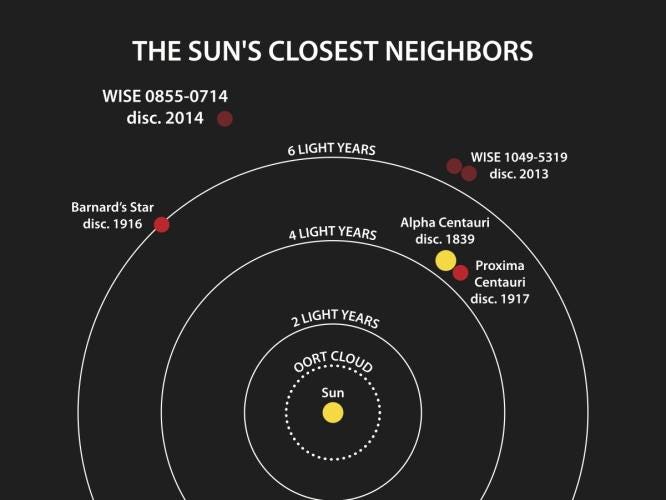
Proxima b an Earth-like exoplanet orbiting in the habitable zone of the nearest star to our own in the Proxima Centauri solar system — located just 4.2 light-years from Earth — has been confirmed by an international team of astronomers from the University of Geneva. The team used the Echelle SPectrograph for Rocky Exoplanets and Stable Spectroscopic Observations (ESPRESSO) spectrograph, attached to the Very Large Telescope (VLT) located in the Chilean desert to make their observation.
The team’s findings are published in the journal Astronomy and Astrophysics.

Proxima b, an exoplanet orbiting a red dwarf star, was initially detected four years ago by an older spectrograph, HARPS, as a disturbance in the star’s orbit, which suggested the presence of another body. These measurements were followed up by the more sophisticated ESPRESSO instrument, currently the most powerful spectrograph on Earth — designed by the same team from Geneva, and essentially HARPS’ successor.
[Read: The asteroid that killed dinosaurs hit at worst possible angle, study finds]
“We were already very happy with the performance of HARPS, which has been responsible for discovering hundreds of exoplanets over the last 17 years,” says Francesco Pepe, a professor in the Astronomy Department in UNIGE’s Faculty of Science and the head of ESPRESSO. “We’re really pleased that ESPRESSO can produce even better measurements, and it’s gratifying and just reward for the teamwork lasting nearly 10 years.”
ESPRESSO carried out measurements of Proxima Centauri’s radial velocity with a stunning accuracy of 30 cm/s, which is about three times more precise than the measurements of HARPS. Thus the astronomers were able to confirm that a planet of at least 1.17 times the mass of Earth orbits the tiny low-mass star once every 11.2 days. The measurement is a slight refinement on that made by HARPS, as the earlier spectrograph had placed Proxima b’s mass at around 1.3 Earth masses.
“Confirming the existence of Proxima b was an important task,” the paper’s lead author Alejandro Suarez Mascareño. “It’s one of the most interesting planets known in the solar neighborhood.”
Goldilocks and the Red Dwarfs (wait… that’s not right)
Excitingly Proxima b exists with its star system’s habitable zone, the region in which water is able to exist as a liquid, as it is neither ‘too hot or too cold, but just right’ a state that results in the alternative moniker ‘the Goldilocks Zone.’

This may could as something as a surprise considering that Proxima b’s incredibly short orbit of just 11 days implies that it is very close to its parent star. And this is certainly the case, Proxima b is twenty times closer to its star than Earth is to the Sun.
Fortunately, Proxima Centauri is much smaller than the Sun and radiates far less energy. This means that the amount of surface energy received by Proxima b is comparable to the energy we receive here on Earth from the Sun. Thus, making the presence of liquid water a possibility.

But, don’t be speculating about life on Proxima b just yet. It may be an ideal candidate for the search for biomarkers — the telltale signs of life — but there are other conditions on Proxima b that may not favour lifeforms. For example, as Proxima Centauri is a red dwarf not a star in its main sequence like the Sun, therefore it bombards Proxima b with about 400 times the X-Rays that we receive from our star.
Christophe Lovis, a researcher in UNIGE’s Astronomy Department responsible for ESPRESSO’s scientific performance and data processing, gives an idea of the kind of questions that need to be addressed before we get too excited about life on this exoplanet: “Is there an atmosphere that protects the planet from these deadly rays? And if this atmosphere exists, does it contain the chemical elements that promote the development of life (oxygen, for example)? How long have these favorable conditions existed?
“We’re going to tackle all these questions, especially with the help of future instruments like the RISTRETTO spectrometer,” says Lovis referring to an instrument that is being built just for the purpose of examining Proxima b’s light absorption looking for distinctive fingerprints that organic molecules leave on light passing through the planet’s atmosphere.
But, even if the chances of life on Proxima b are slim, worry not. There is another…
A new hope? Maybe?
The measurements made by ESPRESSO may have delivered something of an unexpected surprise. The planet may not be alone in it’s Goldilocks Zone. The astronomers found a second signal in data collected by the spectrograph, the source of which they have yet to identify. If the origin of the signal is an exoplanet, it could be a first for the detection of such bodies.
“If the signal was planetary in origin, this potential other planet accompanying Proxima b would have a mass less than one-third of the mass of the Earth,” Pepe adds. “It would then be the smallest planet ever measured using the radial velocity method.”

Maybe the least extraordinary element of the discovery of a tiny companion planet would be the fact that ESPRESSO was able to make it. Since it began operations in 2017, the spectrometer has met its developers’ expectations and exceeded them.
The progress made by the instrument reflects the burgeoning leaps made in the science of exoplanet hunting — afield still in its infancy. Since the discovery of the first exoplanet around a Sun-like star in 1995 the exoplanet-catalogue has exploded with thousands of examples.
And with the launch of ESO’s CHEOPS satellite last year and the forthcoming development of the James Webb Space Telescope and the Extremely Large Telescope, it is likely the most exciting developments are still to come.
Michel Mayor, co-winner of the 2019 Nobel Prize in physics for his discovery of the first exoplanet around a Sun-like star with Didier Queloz in 1995, is one of the architects of the ESPRESSO project. Even he is impressed with the spectrograph’s latest performance.
“ESPRESSO has made it possible to measure the mass of the planet with a precision of over one-tenth of the mass of Earth,” concludes Mayor, honorary professor in the University of Geneva’s Faculty of Science. “It’s completely unheard of.”
This article was originally published on The Cosmic Companion by Robert Lea. You can read this original piece here.
Astronomy News with The Cosmic Companion is also available as a weekly podcast, carried on all major podcast providers. Tune in every Tuesday for updates on the latest astronomy news, and interviews with astronomers and other researchers working to uncover the nature of the Universe.
Read next: 7 experience architecture trends your organization can’t afford to ignore
Corona coverage
Read our daily coverage on how the tech industry is responding to the coronavirus and subscribe to our weekly newsletter Coronavirus in Context.
For tips and tricks on working remotely, check out our Growth Quarters articles here or follow us on Twitter.


